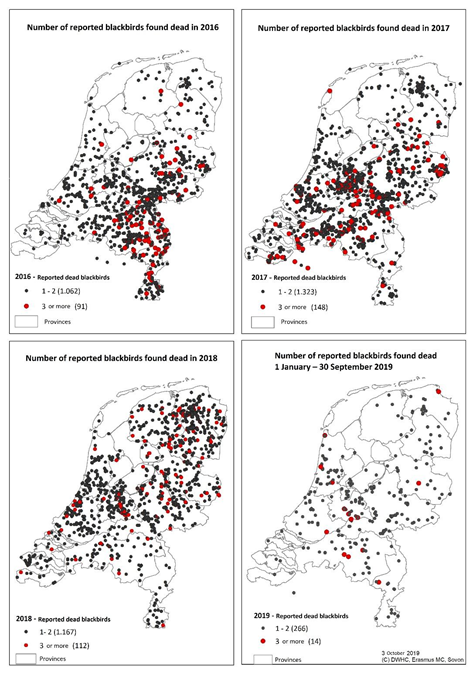Ongoing Usutu virus epidemic in the Netherlands
Still unexplained decline in reported dead blackbirds
Joint press release from the Dutch Wildlife Health Centre, Sovon Dutch Centre for Field Ornothology, Erasmus MC, Centre for Monitoring of Vectors, and Muggenradar.nl
The Usutu virus has been diagnosed in birds in the Netherlands for the 4th consecutive year. As in previous years, the virus has been detected in both wild and captive birds. A big difference with previous years is however the low number of reported dead blackbirds. The reason for this decline is unclear. Are actually less blackbirds dying of the virus or is it just a decrease in reporting?
Dead birds so far reported in 2019
Since mid-August 2019 blackbirds are again dying due to the Usutu virus. The virus has so far been detected in four blackbirds, a barn swallow, a house sparrow, a dunnock, and in three captive bird species (common hill myna, fancy pigeon, zebra finch). In contrast to the previous three years, up to now the number of dead blackbirds reported to and received by Sovon and the Dutch Wildlife Health Centre (DWHC) was clearly lower (see figures 1 and 2).
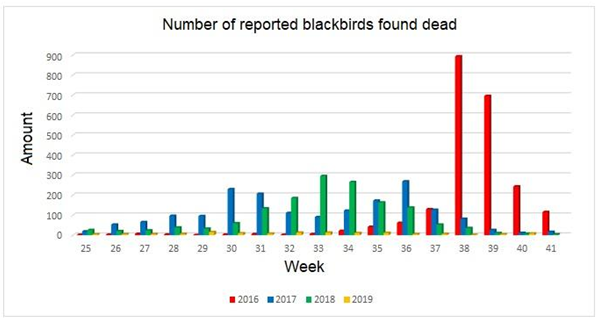
Figure 1. Number of dead blackbirds reported to Sovon and DWHC per week in 2016-2019 (week 25 2016: 20-26 June; week 41 2016: 10-16 October)
Mosquitoes do not explain the decline in reported dead blackbirds
As mosquitoes are needed to transmit the Usutu virus, it is important to know whether fewer mosquitoes will lead to fewer (reported) dead blackbirds. The Centre for Monitoring of Vectors (CMV) measures the number of mosquitoes. Provisional data from CMV show that there is a slight decrease in the number of mosquitoes in 2019 compared to 2018. However, this decrease is so small that it cannot explain the decrease in the number of reported dead blackbirds. In 2017, a year with many reported dead blackbird, the number of mosquitoes was lower than in 2019. In 2016, the first year of birds dying due to the Usutu virus in the Netherlands, there was an extremely high number of mosquitoes in the Netherlands.
Possible other factors for lower number
It is not (yet) clear why the number of reported dead blackbirds is lower than in previous years. There are various factors that can contribute to this decline. For example, the blackbirds may have built up (partial) immunity and be less sensitive to the virus, so that fewer birds die. It is also possible that dead blackbirds are reported less often because the finder assumes the cause is known and reporting is no longer necessary. Another explanation may be that there were fewer mosquitoes infected with the virus in 2019.
Trends in reported dead blackbirds
In 2016, the Usutu virus was first detected in the Netherlands in blackbirds and captive great grey owls. Research by DWHC and Erasmus MC showed that the blackbirds died due to Usutu virus infection. After a press release on the subject, the number of dead blackbirds reported to DWHC and Sovon rose sky-high (see Figure 1). In 2016, the virus was detected in dead birds until mid-October (week 41). In 2017 the first infection with the Usutu virus in a dead blackbird was found at the start of April. But it was then not before the end of June that a clear increase in the number of dead blackbirds infected with the Usutu virus was seen. In 2017, death caused by the Usutu virus continued until mid-October just as in 2016. In 2018, the increase in the number of reported dead blackbirds started at the end of July (week 30) and continued until the end of September.
Although reports of dead blackbirds have come from all over the Netherlands during all four years, figure 2 clearly shows that in 2016 dead blackbirds were mostly found in the south and east of the Netherlands. In 2017 and 2018 the findings moved more to the west, the north, and northwest. A map based on 4000 reports from the human surveillance of the degree of inconvenience caused by mosquitos on Muggenradar.nl in 2016, coincide with the blackbird mortality, (see Figure 3).
Blackbird population
Since a few years, the blackbird population has been declining in the Netherlands. In 2017, a national decrease of four percent in blackbirds was observed in urban areas as compared to the previous year. In 2018 this decline was fourteen percent and in 2019 sixteen percent (Meetnet Urbane Soorten). Interestingly, we see the largest decrease in the south. In the north however a decrease is hardly noticeable up to now. This geographical difference is comparable to that in the number of birds reported dead (Figure 2). The drought in recent years may also have contributed to the decrease. Nevertheless, the blackbird is still a common bird.
Usutu in wild birds
During all four years of the study on dead wild birds, the Usutu virus has been detected mainly in blackbirds. In addition, it was also found in some other dead species (barn swallow, eurasian jay, dunnock, common wood pigeon, house sparrow, fieldfare, eurasian blue tit, european robin, common kingfisher and song thrush) (see figures 4 to 6). For some birds it was not clear whether the bird had died of the Usutu virus or if the bird was only infected with the Usutu virus and the virus was not the cause of the birds death.
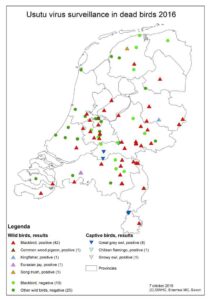 |
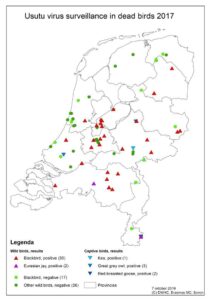 |
| Figure 4: Geographical representation of dead birds that were tested on the Usutu virus in 2016 | Figure 5: Geographical representation of dead birds that were tested on the Usutu virus in 2017 |
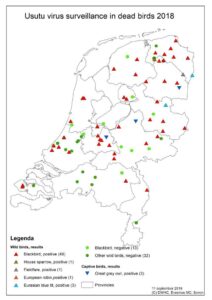 |
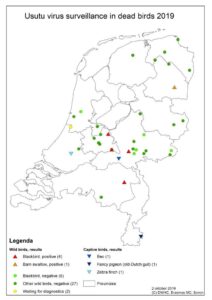 |
| Figure 6: Geographical representation of dead birds that were tested on the Usutu virus in 2019 | Figure 7: Geographical representation of dead birds that were tested on the Usutu virus in 2019 |
Usutu in captive birds
In addition to wild birds, the Veterinary Pathological Diagnostic Center (VPDC) of the Faculty of Veterinary Medicine in collaboration with Erasmus MC found the Usutu virus in a number of captive birds. Great grey owls, also called Lapland owls, are especially susceptible to the virus. Furthermore, mortality due to Usutu virus has been observed in the last four years in Chilean flamingo, snowy owl, red-breasted goose, kea, zebra finch, old-Dutch gull (fancy pigeon) and a common hill myna.
Keep reporting dead birds
The investigation into the mortality of blackbirds will be continued, but it is impossible to collect all reported dead animals for testing. However, reporting remains very important, because it is the only way to gain insight into disease/death among wild animals in the Netherlands. You can report a dead bird to Sovon via sovon.nl/dodevogels or on the DWHC website via the link Report a dead animal here.
More information
More information and previous messages about the Usutu virus can be found at: https://www.dwhc.nl/en/diseases/usutu-virus/
Note: Who is in charge of what?
Reports of dead wild birds: Sovon and DWHC
Research of dead wild birds: DWHC, Faculty of Veterinary Medicine, Utrecht University
Investigation of dead birds: Veterinary Pathological Diagnostic Center (VPDC), Faculty of Veterinary Medicine, Utrecht University
Bird monitoring: Sovon, Dutch Centre for Field Ornithology, Nijmegen
Usutu virus diagnostic test: Erasmus MC, Rotterdam
Mosquito measurements: Centre for Monitoring of Vectors ( CMV ) , National Reference Centre ( NRC ) , Netherlands Food and Consumer Product Safety Authority ( NVWA ) , Ministry of Economic Affairs, Wageningen, The Netherlands
Inconvenience caused by mosquitos: Muggenradar.nl, Environmental System Analysis group, Wageningen University
Text:
Margriet Montizaan, Marja Kik, Jolianne Rijks DWHC
Roy Slaterus, Jan Schoppers, Marcel Wortel, Sovon
Reina Sikkema, Erasmus MC
Arjan Stroo, CMV,
Arnold van Vliet, Muggenradar.nl



